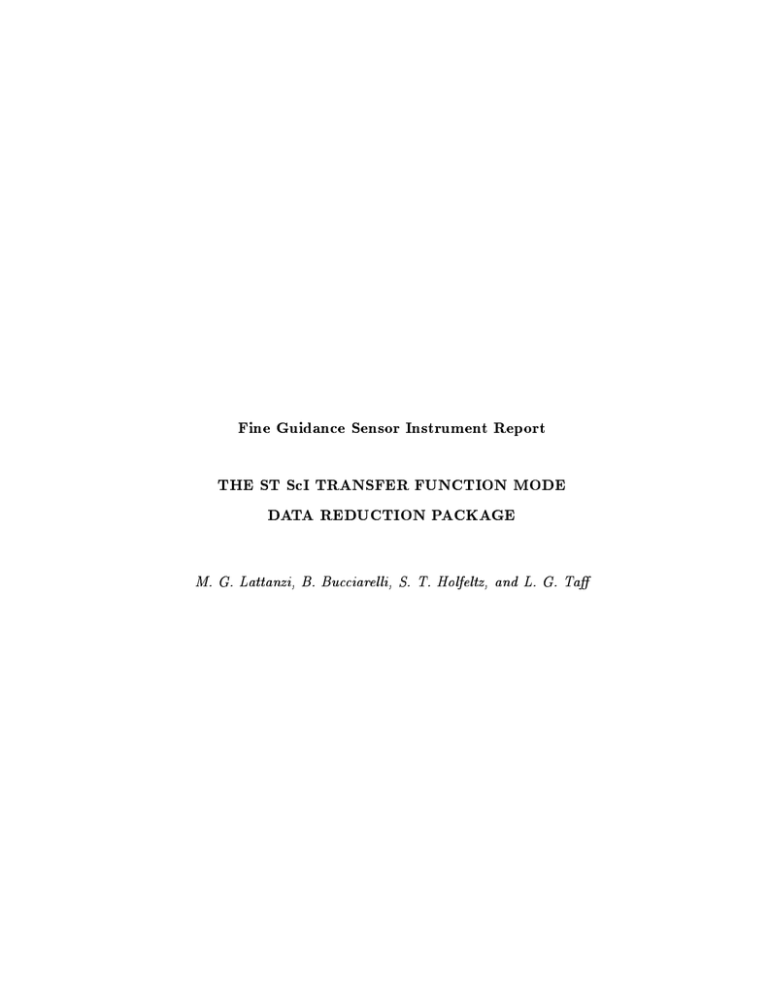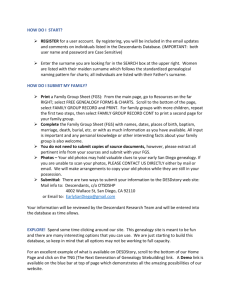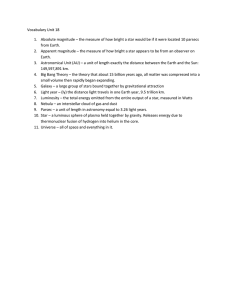Fine Guidance Sensor Instrument Report THE ST ScI TRANSFER FUNCTION MODE
advertisement

Fine Guidance Sensor Instrument Report
THE ST ScI TRANSFER FUNCTION MODE
DATA REDUCTION PACKAGE
M. G. Lattanzi, B. Bucciarelli, S. T. Holfeltz, and L. G. Ta
I. SUMMARY
The purpose of this Instrument Report is to describe the strategy and the basic algorithms that have been implemented in the ST ScI Fine Guidance Sensor Transfer Function
Mode Reduction Package. The Transfer Function Mode Reduction Package software is used
for the analysis of Science Verication data, Instrument Scientist Calibration data, and General Observer scientic data. At present, the Transfer Function Mode Reduction Package
(TFMRP) is the principal tool to be used for all double star data analysis. References to the
actual code are included throughout this report. However, the emphasis is on the techniques
so this Instrument Report can serve as the basic reference for the SDAS personnel who will
actually implement the package in the STSDAS/IRAF environment. Future General Observers will have access to this Report and a new Fine Guidance Sensor (FGS) Instrument
Handbook will also include information that General Observers will need to know regarding
the Institute's ability to help them with their FGS data analysis. A detailed description of
the code and its usage is given in [6].
The present version of the ST ScI TFMRP is designed to do two main things: (1) To
calibrate FGS Single Star transfer functions by using calibration data taken on selected
single stars. Appropriate Calibration Data Base System (CDBS) tables will be populated
(or modied) as a result of these calibration observations and the associated data reduction;
(2) To analyze FGS transfer function observations on double stars. The analysis of triple
stars and extended objects (i.e., angular diameter measurements or measurements of nebular
objects) will be discussed in a future Instrument Report. The calibration data for them will
be acquired during the Cycle 1 Instrument Scientist calibration observations. The basic
transfer function calibration eort consists of a `19 Points of Light' measurement in the
prime FGS, the one in radial bay #3.
II. INTRODUCTORY NOTES
In the following we will assume that the reader has some knowledge of the FGS as an
astrometric instrument and in particular with the TRANSfer function astrometric Mode.
The reader can nd detailed descriptions of the FGS modes of operation in several HST
project documents and journal articles. To guide the reader to this literature, a complete
list of the relevant documents and papers is given in the references at the end of this Report.
We also assume that the FGS TRANS Mode data are retrieved from the DMF/DADS
system through Retlist and decoded using the ST ScI AEDP unpacking software [5].
When running in calibration mode, the TFMRP will produce data for the CDBS or
the PDB (Project Data Base) databases (Fig. 1). For example, as the mis-gured primary
mirror has induced eld dependent aberrations (as seen by the FGSs), it is now imperative
to calibrate the Single Star transfer function all across the FGS eld of view (hence the `19
Points of Light' observations referred to above). As shown in Fig. 1, the present version of
the TFMRP includes data rectication, data smoothing, and double star measurement. The
latter is primarily based on a correlation technique.
In the next three sections each step will be illustrated and a brief discussion of the
relevant algorithms given.
III. DATA RECTIFICATION
Data rectication is comprised of four main corrections, namely the encoder readings
corrections, the photomultiplier tube (PMT) mismatch corrections, the dierential velocity
aberration correction, and the minimization of the spacecraft jitter.
The encoder readings correction refers to the application of a look-up table which contains
a set of values representing the systematic shifts of the encoder readings as a function of
encoder position. These systematic corrections were determined by measurement during
on-ground testing. They are to be delivered by Perkin-Elmer Corp. (now Hughes Danbury
Optical Systems). Both the sign and the amplitudes of these eects are important, for being
systematic errors, applying them with the incorrect parity will double them. The correct
table is still not in the CDBS. More information on the nature and the detection of the
encoder corrections can be found in the Astrometry Handbook [1].
The FGS Transfer Function is usually written as S = (A , B )=(A + B ) where A and B
are the photomultiplier counts from the two photomultiplier tubes per axis. (Acquiring the
photomultiplier counts by moving the FGS instantaneous eld-of-view across the scientic
target is referred to as scanning the target so sometimes the transfer function is called a
transfer scan.) There are two axes per FGS (arranged by a polarizing beam splitter); the
subscript x or y is added to S in order to specify which axis is meant. Similarly, an x or
y subscript is attached to A and B when clarity is needed. The PMT counts vary in a
regular fashion with the angular distance between the current location of the center of the
FGS instantaneous eld-of-view and the interferometer null (which is roughly aligned with
the optical axis of the HST). To concretely x ideas, a set of transfer functions, as expected
before launch, is given in Fig. 2. The zero noise, ideal equation for the transfer function, as
illustrated in Fig. 2, predicts that S will vanish when the instantaneous eld-of-view is far
away from the optical axis (say > 0:1 arcsec). In practice, this condition is rarely realized
because A and B are never equal far from the null (or even exactly at it) as a consequence
of mismatch in the responsitivity or sensitivity of the two photomultiplier tubes. Thus, a
PMT mismatch correction is necessary. It consists of the computation of the mean value of
A , B far from the null (say ab). The revised version of S takes the form
S = (A , B , ab)=(A + B ):
(1)
This mismatch correction is applied in the subroutine MAKE SCURVE.
The dierential velocity aberration correction includes the reduction of the observed
line of sight to the solar system barycenter in a reference frame of xed orientation (e.g.,
J2000.0). It includes the motion of the HST spacecraft about the center of mass of the
Earth, the motion of the center of mass of the Earth about the Earth-Moon barycenter, and
nally the motion of the Earth-Moon barycenter about the solar system barycenter. (The
intermediary of going to the heliocenter is unnecessary.) Dierential velocity aberration plays
a much bigger role in the reduction of POSitional Mode data than it does in the reduction
of TRANSfer Mode data so it is discussed in the POS Mode Instrument Report [8].
The minimization, and hopefully complete removal, of the solar-array induced jitter will
be a major task during data rectication. Since all FGS data should be taken in the 32
Kbit telemetry mode, we will have the maximum amount of information, from the Guide
Stars, with which to accomplish this. An algorithm for jitter removal does exist but further
investigation is needed to determine if it is sucient. The current approach is that of
executing multiple scans while taking science data in TRANS Mode. In this way, jitter
corrupted scans can be easily identied (by comparison to the others) and removed from the
set which will then be processed through this pipeline. Actual observational data provides
an estimate of an average of 2{3 (unusable) jitter corrupted scans out of 10.
IV. DATA SMOOTHING
In this section we discuss the data smoothing technique which is applied to the transfer
function data after rectication. The idea here is to t the raw data in such a way that
all the essential features in the transfer function are preserved in a noiseless (or at least a
higher signal-to-noise) version. A cubic-spline t might be deemed appropriate for this; we
decided instead to use a piece-wise polynomial t for two reasons. First, as this technique
is close to the spline approach, we expected analogous performance (see Fig. 3). Second, a
polynomial representation of the smoothed transfer function makes it possible to compute
the correlation integral (used during double star measurement) analytically (see Eq. (3) xV).
In the next two sub-sections we will detail our approach to tting the S curve.
a) Functional Fitting
Having obtained the experimental curve (dotted curve in Fig. 3), which is a function
of the instrumentally and scientically corrected star selector encoder angle readings, we t
it piecewise to low-order polynomials. The ts are executed via a constrained, non-equally
weighted, least squares algorithm. Since this is a photon (i.e., Poisson) process we know
the standard deviations of each value of S . Hence, we can reliably determine weights. The
polynomials (we allow linear, quadratic, and cubic) are forced to obey continuity conditions
at their joining points. In addition, depending on the degree of the polynomial, we may also
demand dierentiability and even a higher order of smoothness (all enforced by Lagrange
multipliers at the joining points).
There are two renements to this procedure. One is that the choice of the mean width
of the intervals is governed by a minimum number of pairs of photomultiplier counts per
interval constraint. The other is that the upper limit for a particular interval's width is
governed by the local curvature. The analytical details are in the next subsection. The
piecewise linear continuous t to the data is shown in Fig. 3.
b) Analytical Details
Dene H (x) to be the usual Heaviside function,
(1 x 0
H (x) =
0 x < 0:
So, if a < b then h(x; a; b) = H (x , a)H (b , x) has the properties
80 x < a
>
>
<
h(x; a; b) = > 1 x 2 [a; b]
>
:
0 x > b:
Next dene N joints (or knots in spline terminology) z1, z2, : : :, zN . The joints are where we
will enforce continuity, smoothness, and so on. We also need the general polynomial Pd(x)
of degree d; viz.
P (x) = a + bx + cx2 + + qxd:
As we shall need one d'th order polynomial per interval (the boundaries of the intervals are
dened by the set of joint locations fzng), we will use a double indexing scheme for the
coecients in P = Pn (n = 0; 1; 2; : : : ; N )
Pn (x) = an0 + an1x + an2x2 + + andxd
Pn is dened everywhere [i.e., x 2 (,1; 1)] but will only be used on [zn; zn+1].
We want to represent a function F (x) on x 2 [xmin; xmax], where xmin = z1 and
xmax = zN , by a linear combination of N , 1 d'th order polynomials fPng which obey
various boundary conditions at fzng. Thus, we write
NX
,1
F (x) =
h(x; zn; zn+1)Pn(x)
n=1
where, were we only enforcing continuity at the N , 2 interior points fzng one would have
the constraints
Pn (zn+1) = Pn+1 (zn+1); n = 1; ; N , 2:
We also want the determination of the fanmg to rest on least squares given that we have
measured F (x) at xmin = x1,x2, : : :, xL = xmax. Thus, we form
L
NX
,1
NX
,2
X
Rc = w`[F (x`) ,
h(x`; zn; zn+1)Pn (x`)]2 ,
n+1 [Pn(zn+1) , Pn+1 (zn+1)]
n
=1
n
=1
`=1
and minimize Rc with respect to the (N , 1)d values of fanmg and the N , 2 Lagrange
multipliers fn g. (In practice, we do not solve for the Lagrange multipliers in the formal
way but instead enforce the constraint conditions as additional equations of observation with
extremely high weights; the relative weights are typically 106 to 1.) The weights w` are
the photon-noise implied weights of the Transfer Function from Eq. (1). There is a point of
subtlety for A and B are anti-correlated; thus
p p
S = ( A + B )= < A + B >; wS = 1=S2
in the notation of Eq. (1).
The extension to incorporate smoothness at the joints is accomplished by minimizing Rs
instead of Rc;
NX
,2
Rs = Rc ,
n+1[Pn0 (zn+1) , Pn0 +1(zn+1)]
n=1
dP
(
x
)
n
where Pn0 (zk) means dx jx=zk .
The constrained piece-wise least squares t to the rectied S curve data is performed
with a call to the subroutine SCURVE INTERP.
V. DOUBLE STAR MEASUREMENT
a) The Calculation of the Parameters of a Binary Star
Double star measurement refers, in the present version of the code, mainly to the determination of the parameters of double stars. It includes, at the moment, two dierent
(although interconnected) functions, namely (1) the co-adding of several scans on the same
scientic target and (2) the determination of the two separations (dx and dy), the magnitude
dierence between the primary and the secondary components (m), and, ultimately, the
computation of the position angle (PA) of double stars. In xV:b below, we will discuss the
determination of dx, dy, and m, and then the simpler problem of co-adding scans. The
computation of PA is detailed in xV:c.
b) Algorithm Details
Assume that we know the form of the `Single Star' transfer function, that is the reference
transfer function for this place in this FGS. The hypothesis is that the incoming light from
two dierent sources, close by on the celestial sphere, is incoherent and the application of
the superposition principle yields the expected Double Star transfer function, D(x) in the
form of a linear combination of two single star transfer functions S , viz.
D(x) = A(m)[S (x + x0) + B (m)S (x + x0 + dx)]
(2)
(and its analog for the y-axis), where the second single star transfer function S (x + dx)
is identical to the rst but displaced along the X -axis by an additional amount dx, the
projected double star separation. The shared shift of x0 in the single star reference transfer
function is to correct for an arbitrary translation between the reference star transfer function
and those of the double star under study. A(m) is an overall normalization factor. B (m)
represents the intensity ratio between the primary and the secondary stars comprising the
double. Both of these factors depend on the apparent magnitude dierence between the two
stars, m.
The model just described is tted to the observed transfer function curve and the parameters dx and m derived. It is worth noting here that two independent estimates of m
are potentially available, one from each FGS axis.
In practice, a grid of models is generated by varying dx and m. Each model is crosscorrelated with the observed transfer function by computing the correlation integral
Z
C = D(t , u)S (t)dt:
(3)
The template function D is being cross-correlated with the actual Koester's prism fringe
visibility function S . The sought-for value of u, which maximizes the correlation integral C ,
represents the shift along this axis between the two functions. The optimum value will be
denoted by u0.
The best-t model is chosen as the one with parameters which minimize the sum of the
squares of the dierences between the theoretical model in D and observed values in S , viz.
Z
[D(t , u0) , S (t)]2dt = minimum:
(4)
This approach was preferred to the direct application of a least squares-like scheme for its
robustness|in relation to the range of narrow separations (from 100 mas down to about 10
mas) where the astrometer FGS will make its most interesting detections|and the independent diculty of giving suciently accurate initial guesses for dx and m. However, if felt
necessary, the accuracy of the t can be improved, now using the answers from the correlation technique as initial guesses for a nal least squares adjustment. Indeed, all possible
options of correlation/least squares tting are supported.
As discussed in xIV , before running the cross-correlation process, the photon noise in the
observed transfer function is smoothed via a piece-wise low-order polynomial t. Continuity
is imposed at the bin boundaries up to a specied level (i.e., continuity, rst derivatives
continuous, or second derivatives continuous). This polynomial smoothing increases the resolution of the subsequent cross-correlation and makes it possible to compute the correlation
integral C , as well as the sum of squares to be minimized, analytically.
While not described in detail herein, there is a completely separate least squares version
of this process (see the Franz et al. paper [10].), and a Fourier technique has also proven
applicable (J. Hershey, in press).
b.1) Shifting the Transfer Functions
At this stage of the data processing the transfer functions from the dierent scans have
been transformed into piece-wise continuous polynomials of a given degree. As explained
above, owing to spacecraft motions, the template transfer function (D) and the actual transfer function (S ) are not taken at the same location of the FGS x or y axes. To avoid stepping
too many times through the loop in x0 [see Eq. (2)], a coarse centering of D(x) with respect to the observed S (x) is rst performed in the following fashion. First, we compute the
distance of D(x) to S (x) as
x = xs , xd;
(5)
where xs and xd are the reference points dened by
xs = (xs;max , xs;min)=2
and similarly with a d subscript. To shift D(x) closer to S (x) we apply the translation
x0d = xd + x;
(6)
to the template curve D(x). This transformation requires that the coecients of the polynomial representing the template be transformed accordingly. The new coecients as a
function of the old are given in Appendix 1.
b.2) Creating a Double Star Template
The actual formula used to generate a Double Star (D) template is [see also Eq. (2)]
(,0:4m)
D(x) = R(x) + 10 (,0:4Rm()x + dx) ;
(7)
1 + 10
where R(x) is a single star transfer function taken as close as possible, within the FGS
eld-of-view, to the FGS location of the scientic observation S (x). Naturally, a formula
analogous to Eq. (7) applies for the y axis.
Once dx is xed we can shift R(x) to the new location x + dx. This will serve to
represent the transfer function of the `secondary' star (of course the assignment of primary
vs. secondary is just a matter of convention) of the template double along the x axis. Note
though, the apparent magnitude dierence has not yet been taken into account. Given m,
Eq. (7) takes into account the contribution of the secondary star to the total intensity.
b.3) The Calculation of the Integrals
The heart of the subroutine CORR TRANSF that correlates the observed scan and the
current template (i.e., given m and dx) nds the x0 value that best correlates the two
transfer functions, now represented by polynomials, according to Eq. (3). This integral
can be evaluated analytically because of the simple, analytical representation we have developed for the smoothed transfer function; see Appendix 2. Similar comments apply to the
minimization integral in Eq. (4); see Appendix 3.
b.4) Co-Adding Dierent Scans
Co-adding Transfer Scans refers to adding together multiple scans, taken on the same
scientic target. This would be done to improve the signal-to-noise ratio both for fainter
targets and as a primitive jitter smoothing technique. Since the coordinate system in which
the transfer scans are acquired is not rigidly xed, we need to determine the translation
that has occurred between successive scans. This is represented by the parameter x0 in
the above equations. Thus, in a sense, we want to best t one of the many scans acquired
on a scientic target not with a single star reference transfer function, but with that scan
of this target labeled the `reference' scan. The procedure to do so is identical to that for
tting a binary star, only this is a one-parameter problem not a three-parameter problem
(i.e., no need for dx nor m). The same software that was just described can, therefore,
be used for this simpler purpose by constraining the values of these parameters. This is
what we do. Suppose we want to co-add a set of scans taken on a single star. Subroutine
CORR TRANSF is then used with both dx and m set to zero. Suppose also that one of
the scans is chosen as the reference (ref). Then, we rst coarse shift the remaining ones to
the reference scan as described in xV:b:1. Let us call shifti = xsi , xref the computed displacement on the X axis of the i'th scan from the reference. Here, xsi = (xi;max , xi;min )=2
and xref = (xref;max , xref;min )=2. The residual shift, x0max, is calculated from the implementation of Eq. (3) discussed in xV:b:3. Then, before co-adding the i'th scan to the
reference one, the following transformation is applied to the X (Y) coordinate of the i'th
scan
x0 = x + shifti , x0maxi
(8):
The formula given in Eq. (8) has been proven eective to better than 5 milli-second of arc.
Of course, the co-adding scheme can be dierent (for example, we can co-add the reference and one of the remaining scans, dene the result as the new reference and repeat
the co-adding step with another of the remaining scans) but Eq. (8) remains the basic
transformation to be applied to the scan that is currently being co-added.
c) The Computation of the Position Angle
The computation of the position angle (PA) is done in a completely dierential way. As
discussed above, the double star measurement outputs dx and dy, the separations between
the two stars, along the interferometer X and Y axes. These quantities are expressed in the
FGS image space in seconds of arc on the sky (demagnied). Both dx and dy are very much
less than one arc second. We assume that dierential optical distortions can be disregarded
over such a small scale length. Thus, to transform dx and dy (considered as a plane vector
with origin at the primary component of the double) into the V2{V3 plane we have to only
account for the relative orientation of the two frames by using the most recent (on-ight
calibrated) alignment matrices. The distortion correction tables are not applied.
The present version of the code uses the pre-launch transformations matrices, i.e.
V 2 = ,Y; V 3 = X
(FGS 1)
V 2 = X;
V3=Y
(FGS 2)
V 2 = Y; V 3 = ,X (FGS 3).
We have adopted the denition of the V 2{V 3 plane as given in [2] Bradley et al. (1991,
see their Fig. 1). The use of real alignment matrices will result in a small coupling of the
q
reference axes and it requires the component dz dened as 1 , (dx2 + dy2).
Once in the V 2{V 3 plane, knowledge of the spacecraft orientation (attitude) with respect
to a reference equatorial North (i.e., at a specied epoch and equinox) gives the position angle
of the double. The formula is, with all quantities in degrees,
PA = 360 , ANGV3 + arctan(V 2=V 3):
(9)
ANGV3 species the orientation of the V 3 axis as dened by the angle from the North
counted positive through West (see Fig. 4). This quantity is given with quite good accuracy
(of the order of 0.5 deg) in the FGS AEDP header les. As shown in Fig. 4,
PAV3 = 360 , ANGV3 is the position angle (in the astronomical sense, i.e. the angle is
counted positive from North towards the East) of the spacecraft V 3 axis. The reference
equatorial North is that at equinox J2000.0 and epoch of the date. Eq. (9) is implemented
in the subroutine POS ANGLE.
Notice that the position angle given in Eq. (9) would only be exact if the location of the
double observed in the FGS 3 pickle coincides with the V1 axis. Of course, this will never
be the case as the pickle is some 10' away from the V1 axis. However, Eq. (9) is appropriate
for most applications. The exact expression for PA will be given in a forthcoming memo.
FGS-RELATED REFERENCES
1. HST Astrometry Operations Handbook, NASA, SMO-1040, 1987.
2. Bradley, A. et al. 1991, PASP, 103, 317.
3. Ta, L. G. and Lattanzi, M. G. "Hubble Space Telescope Fine Guidance Sensor Instrument
Handbook," Version 2.1, 1990.
4. OTA Project Report, Perkin-Elmer, PR-841, January 1984.
5. Bucciarelli, B. and Lattanzi, M. G. 1991, "AEDP Astrometry Products Unpacking
Software", ST ScI FGS Instrument Report (May 1991).
6. Holfeltz, S. T. et al. 1991, "Data Smoothing and Double Star Data Reduction in the
Transfer Function Mode Reduction Package". ST ScI FGS Instrument Report (Dec. 11,
1991).
7. Bucciarelli, B., Lattanzi, M. G., Ta, L. G., Franz, O. G., Wasserman, L., and Nelan, E.,
1991, "Detection of Binaries with The FGS: The Transfer Function Mode Data Analysis",
in The First Year Of HST Observations.
Proceedings of a Workshop held at the ST ScI (A.L. Kinney and J.C. Blades, Eds), p.238.
Baltimore, MD, 14-16 May.
8. Ta, L. G., "Scientic Results from the Hubble Space Telescope Fine Guidance Sensors,"
SPIE 1494, 66, 1991.
9. Bucciarelli, B., Lattanzi, M. G., Ta, L. G., 1992, "The ST ScI POSition Mode Data
Reduction Code (Version 1.0 Dec. 13, 1991)", SPD/TIB Memorandum (March 26, 1992).
10. Franz, O. G., Wasserman, L. H., Nelan, E., Lattanzi, M. G., Bucciarelli, B., and Ta, L.
G, 1992, "Binary Star Observations With The Hubble Space Telescope Fine Guidance
Sensors II. Bright Hyades", Astron. J. vol. 103 no. 1.
Appendix 1
Transformation of the polynomial coecients
Let Pi(x) be the polynomial representing the smoothed TF (actual or template) in the
i'th bin xi x xi+1. The degree of this polynomial is ndeg (the degree of the polynomial
does not change from bin to bin). Let us write Pi(x) as
ndeg
X (i) `
(1:1)
Pi(x) =
a` x :
`=0
Next, we apply the transformation
x0 = x + xt
to Eq. (1.1), which gives
Pi (x0) =
ndeg
X
a(`i)(x0 , xt)`:
`=0
After expanding the expression (x0 , xt)`, and assuming that ndeg=3 (the highest degree
we consider for the tting polynomials), we obtain the nal expression
Pi(x0 ) = a(0i)c00 + a(1i) c11(,xt) + a(2i)c22(,xt)2
+ a(3i)c33(,xt)3
(1:2)
+ fa(1i)c10 + a(2i)c21(,xt) + a(3i)c32(,xt)2gx0
+ fa(2i)c20 + a(3i)c31(,xt)gx0
+ a(3i)c30x0 :
From Eq. (1.2) we can derive the table of transformation for the coecients, i.e.
ndeg
X (i ) `
0
a0i =
a` c`(,xt)`
`=0
ndeg
X (i ) `
a01i =
a` c`,1(,xt)`,1
`=1
(1:3)
ndeg
X (i ) `
a02i =
a` c`,2(,xt)`,2
`=2
ndeg
X (i ) `
a03i =
a` c`,3(,xt)`,3;
`=3
`
!
`
where ndeg = 3 and ck = k!(`,k)! . Eqs. (1.3) have been implemented in the subroutine
SHIFT DT.
2
3
Appendix 2
Direct approach to correlating FGS Transfer Scans.
Consider the fundamental relation
Z +1
(2:1)
C (x0) =
S (x)D(x + x0)dx:
,1
We seek the x0 that maximize the expression (2.1), where S (x) is the observed TF scan. We
can write it as
Z xmax
C (x0) = x S (x)D(x + x0)dx
min
where [xmax , xmin] is the size of the correlation window, i.e. the region where both S and
D are dierent from zero. Since both the actual (observed) scan S and the template D are
piecewise polynomials, we can write
nbin
X Z xj
(2:3)
C (x0) =
Sj (x)D(x + x0)dx
x
j
,
j =1
where x0 xmin and xnbin xmax, and nbin is the number of bins of the piecewise
polynomial S . (Indeed, x0 should be dened as x0 minfxmin, abscissa of left limit of the
rst bin of S g. The same holds for xnbin.)
h
i
h
i
Now, given the bin xj,1; xj , we consider the segment xj,1 + x0; xj + x0 . Then,
perform the change of variable
(2:2)
1
x + x0 = x0; dx0 = dx
and substitute into Eq. (2.3). This gives
nbin
X Z xj +x ynbinj
(2:4)
C (x0) =
Sj (x0 , x0)D(x0 )dx0:
x
+
x
y
j =1 j ,
To understand Eq. (2.4), let us think about the process of nding all the template bins in
the region [xj,1 + x0; xj + x0]. Suppose there are nbinj of such bins. Then Eq. (2.4) can be
rewritten as
0
1
(2:5)
0
0
nbin
X nbinj
X Z yk
C (x0) =
Sj (x0 , x0)Dk (x0)dx0 :
y
k
,
1
j =1 k=1
Eq. (2.5) makes it explicit that Sj and Dk are the actual polynomials representing the
observed S curve in the bin [xj,1; xj ] and the template D in the bin [yk,1; yk], respectively.
Here, yk and yk,1 are the limits of the k'th template bin within y0 = xj,1 + x0 and
ynbinj = xj + x0 [see Eq. (2.4)]. Both Sj and Dk are polynomials, thus
degs
X degd
X
0
0
Sj (x , x0)Dk (x ) =
a`+1;j (x0 , x0)` am+1;k(x0)m :
(2:6)
Considering that
`=0 n=0
n
X
cnpan,pbp
p=0
cnp = p!(nn,! p)!
(a + b)n =
it follows that
(2:7)
(x0 , x0)` =
Hence, inserting Eq. (2.7) into Eq. (2.6),
(2:8)
X̀ ` 0 `,p
cpx (,x0)p:
p=0
(
)
0
1
nbin
X nbinj
X ndegs
X ndegd
X Z yk (S) (D) 0m @ X̀ ` 0(`,p)
c(x0) =
a`+1;j am+1;kx
cpx (,x0)pA dx0;
y
p=0
j =1 k=1 `=0 m=0 k,1
where ndegs is the degree of the polynomial S and ndegd is the degree of the polynomial D.
Note: If x0 = 0 we have to resolve the form 00 coming from the term (,x0)p in Eq. (2.8).
Since that comes from the expression for (a + b)n, when x0 = 0 it means that (x0 , x0)` = x0` ,
and Eq. (2.8) becomes
(2:8a)
nbin
X nbinj
X ndegs
X ndegd
X Z yk (S) (D) 0m 0` 0
a`+1;j am+1;k x x dx :
j =1 k=1 `=0 m=0 yk,1
We can now solve the integrals in Eq. (2.8) or Eq. (2.8a) as follows
3
Z yk (S) (D) 2 X̀
m
`
,
p
4 c` x0
a a
(,x0)p5 dx
yk, `+1;j m+1;k p=0 p
) X̀ cp̀(,x0)p y(m+`,p+1) , y(m+`,p+1) ;
= a(`S+1) ;j a(mD+1
;k
k
k,1
p=0 m + ` , p + 1
which, substituted into Eq. (2.8), nally gives
2
3
p nbin
X̀
X nbinj
X ndegs
X ndegd
X
c
(
,
x
)
0
a`+1;j am+1;k 4 m +p̀ ` , p + 1 ykm+`,p+1 , ykm,+1`,p+1 5 :
(2:9)
p=0
j =1 k=1 `=0 m=0
(
1
+
)
Appendix 3
and
The computation of the integral in Eq. (3) of xV:b
Let us assume that
ns
X
f (x) = aix(i,1)
i=1
g(x) =
nd
X
bix(i,1)
i=1
are, respectively, the actual TF scan and the template polynomials in one of the template
bins [d2 , d1]. Then,
Zd
Zd
Zd
Zd
2
2
2
(3:1)
[f (x) , g(x)] dx =
f (x) dx + g(x) dx , 2 f (x)g(x)dx:
2
2
d1
d1
2
2
d1
d1
The various terms on the right hand side of Eq. (3.1) are (after a little algebra)
1
2
ns
,1 0 X
i
X
@ a`ai,`+1 A x(i,1)
f 2 (x) =
i=1 0`=1
1
2
nd
,1 X
i
X
@ b` bi,`+1A x(i,1)
g2(x) =
i=1 `=1
(3:2)
ns
nd
ns+X
nd,1
X i,1 X
(
i
,
1)
f (x)g(x) = aix
bix
=
ci x(i,1)
i=1
0 i=1
1 i=1
ns+X
nd,1 X
i
@ a`bi,`+1 A x(i,1)
=
i=1
`=1
given that
ak = 0 8 k [ns + 1; max(ns + nd , 1; 2ns , 1)]
and
bk = 0 8 k [nd + 1; max(nd + ns , 1; 2nd , 1)]
we nally have
Zd
d1
2
2ns
i
X,1 (i,1) X
x
a`ai,`+1 jdd
i=1
`=1
2nd
i
X,1 (i,1) X
+
x
b`bi,`+1 jdd
i=1
`=1
ns+X
nd,1
i
X
,2
x(i,1) a`bi,`+1 jdd :
i=1
`=1
[f (x) , g(x)]2dx =
2
1
2
1
2
1
cc: J. C. Blades P. Bely B. Bucciarelli O. G. Franz Lowell Obsv. Mars Hill Road 1400
W. Flagsta AZ 86001 R. Hanisch J. Hershey S. T. Holfeltz J. C. Hsu W. Jereys University
of Texas Dept. of Astronomy Austin TX 78712 M. G. Lattanzi F. D. Macchetto F. Paresce
E. Schreier R. Shaw E. Stobie H. Stockman L. G. Ta





